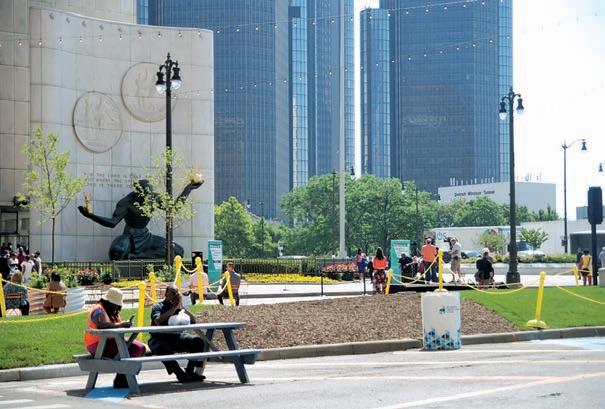
3 minute read
Federal bankruptcy court hears pension payment arguments City, police and re retirees pension fund in dispute over timeline to pay into programs
BY ARIELLE KASS
A dispute over how long the city of Detroit has to fund pensions for police and re retirees is in the hands of a federal judge, a legacy of the city’s decade-old bankruptcy ling.
Advertisement
omas J. Tucker, the federal bankruptcy judge in the Eastern District of Michigan who heard arguments over the phone Wednesday, said he understood representatives of the city and the pension fund were eager for a ruling as to whether Detroit had 20 years or 30 to pay into pension programs. e Plan of Adjustment approved with the city’s bankruptcy ling in 2014 gave Detroit a 10-year “vacation” from making payments, but with that window ending this summer, there is disagreement between the parties regarding who gets to decide how quickly payments must be made.
Charles Raimi, representing the city of Detroit, argued that a con rmation order approving the plan to exit bankruptcy laid out a 30-year time period to replenish the pension fund’s co ers. In lings, the city said the 30-year period was necessary to make the math work, and a shorter payment window would mean disinvestment in other city priorities, including public safety. Additionally, the city said a miscalculation discov- ered after the plan had been approved meant Detroit had not had a break from contributing to its pension fund after all; a Retiree Protection Fund has close to $500 million squirreled away and will be used to cover the gap in the coming years.
On the other hand, the Police and Fire Retirement System’s argument for a 20-year time period rested on the question of control.
Jennifer
Green,
an attorney reprsenting the PFRS, questioned why there was a pension board at all if they wouldn’t be able to decide the time frame for paying back the debt that is owed to them.
Green argued that the Plan of Adjustment only governed the rst decade after bankruptcy and said the PFRS’ board of trustees should be able to make decisions after that period about what was best for them.
“ e nancial projections were merely a placeholder,” she told the court, asking why they would be part of the con rmation order, but not the Plan of Adjustment, if they were meant to be binding.
She said the order was “littered with assumptions,” including expectations for casino revenues and other sources of income. It was “essentially a best guess into the future,” she proposed. And while the Plan of Adjustment was negotiated over months, she said, the same wasn’t the case for the gures that appeared in the nal order. She said if the city is victorious, the court’s action would enjoin the PFRS board “from ever making an amortization decision,” something she said would undermine the board’s authority.
Tucker pushed back against Green, asking about the e ect on the plan if he sided with the city. She mostly sidestepped the questions.
“You don’t like my hypothetical questions because you’re not answering them, you’re ghting them,” he noted.
Raimi had no qualms about pushing back on Green’s logic.
“ eir theory, it’s legally unsound,” Raimi said. “It just makes absolutely no sense whatsoever.”
He argued that the conclusion by the court that the city would be able to service its post-bankruptcy debt was dependent on the decision to give them 30 years to pay into the pension fund, a mandate “as nal and binding as anything that appears in the plan itself.” If it were only 20 years, Green said she thought an additional $12 million annually would be required by the city.
“PFRS’ argument is false on all accounts,” Raimi said.
He called the retirees’ settlement “miraculous” and said it would not have been achieved if the city thought it had 10 fewer years to make payments. Additionally, he said he worried that the PFRS could later decide to reduce the amortization window to ve years, or even one year — and that a victory in this case could lead the General Retirement System fund to also ask for a shorter window.
In lings, the city said that could have a detrimental e ect on its ability to continue its post-bankruptcy recovery plan.
“ is, in our view, is a classic baitand-switch,” Raimi said.
Tucker said he planned to issue a written decision as quickly as possible. After all, he said, the 10-year nonpayment window was closing quickly.
“2023 is here,” he said.
Contact: arielle.kass@crain.com; (313) 446-6774; @ArielleKassCDB
At its heart, a business is about people. A group of people coming together to create something bigger than themselves. To create a solution or a product or an experience in the service of other people. At Huntington, it’s our belief that running a business is about more than making money, it’s about making people’s lives better. So let’s roll up our sleeves and get to work, together.









